The Ultimate Guide to Mythology in Chinese || 64 Mythical Beings
Everything You Need To Know About Chinese Mythology
Throughout Chinese history, tales of various good and evil mythological entities were noted down and passed down with the earliest records being traced back over 3,000 years!
To start, let’s learn the main word:
In Chinese, Mythology is 神话 (shénhuà)
DID YOU KNOW || Chinese mythology is closely linked to Chinese folk religion and has been influenced by religions such as Taoism and Buddhism.
Check out our blog post about religion in Chinese for more interesting information!
Chinese Mythology || The Four Guardians
Chinese Mythology || China’s Mythological Creatures
Chinese Mythology || Chinese Gods and Goddesses
Chinese Mythology || Mythology Around the World
Chinese Mythology || FAQs
The Four Guardians
The Four Guardians, or the Four Symbols are Chinese mythical creatures associated with the four cardinal directions, who are dated all the way back to the 2nd Century BC!
They are; the Azure Dragon of the East, the Vermilion Bird of the South, the White Tiger of the West, and the Black Tortoise of the North.
The Azure Dragon of the East

The Azure Dragon is known as Qīnglóng 青龍, and is one of the Dragon Gods that represents the strength of the Highest Deities of the Five Regions, the Wǔdì 五帝, which are essentially the five deities that collectively make up Taiyi 太一 (Tàiyī ), the God of Heaven.
The Azure dragon also represents the East direction and the Spring season.
DID YOU KNOW – The Azure Dragon was featured on the very first Chinese national flag in 1862-1912 during the Qing dynasty!
In general, Dragons 龙 (lóng) are legendary creatures famously associated with Chinese culture, from being an auspicious Chinese Zodiac sign to the traditional Chinese Dragon Boat Festival, and are considered to be good luck.
Dragons also symbolise health, strength and protection.
In Chinese mythology dragons are considered to be good and kind, and are typically illustrated as having a snake-like body with four legs and small or no wings but still with the ability to fly.
Unlike their counterparts, Western dragons are usually seen as evil and have big wings and with the ability to breathe fire.
DID YOU KNOW || There are quite a few different types of dragons in Chinese mythology who all have their own specific roles.
For more fun trivia about dragons, head over to our post about Chinese dragons.
Vermilion Bird of the South
The Vermilion Bird 朱雀 (Zhūquè) is described as an elegant and noble bird that represents the south direction and the Summer season.
This creature is quite often depicted as red and phoenix-like looking, but make no mistake – the Phoenix and the Vermilion bird are actually two different entities!
The phoenix, most commonly referred to as the Fènghuáng 凤凰 in Chinese mythology, is an immortal mythological bird considered to be the legendary ruler of all birds, whose presence is seen as a symbol of a grace and virtue.
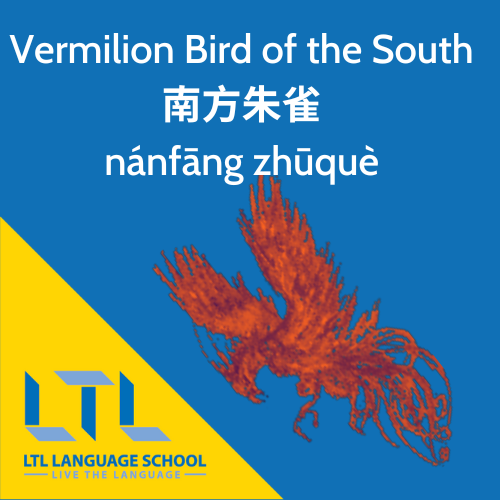
It’s also believed that it only appears in peaceful and happy places.
Records of this creature date all the way back to the Shang dynasty!
Descriptions of the Fènghuáng’s appearance vary depending on the source, but traditionally it’s described as having a rooster’s beak, a swallow’s face, a snake’s neck, a fish’s tail, a stag’s back legs and a fowl’s forehead.
However, more recently the Fènghuáng commonly has more bird-like features, such as a parrot’s beak, a crane’s legs, a golden pheasant’s head, a swallow’s wings and a duck’s body.
That’s quite a lot of features borrowed from different animals, so if you would like to refresh your animal vocabulary, check out our blog post!
DID YOU KNOW || The phoenix is quite a well-known icon within various different cultures and not just the Chinese mythology, but also has very similar counterparts within the Ancient Egyptian, Greek, Slavic and Indigenous American mythology and folklore.
The Black Tortoise of the North
The Black Tortoise, also known as Xuánwǔ 玄武, represents the north direction and the Winter season, and is known as a symbol of endurance and longevity.
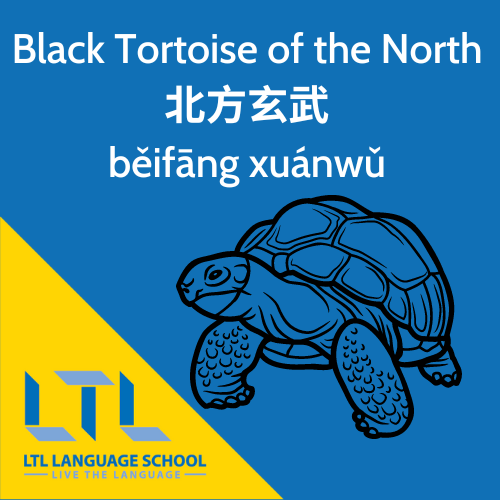
Xuánwǔ shares the same name with the taoist god Xuánwǔ, who is quite often described as having two companions, a tortoise and a snake, accompany him on his quests.
The Black Tortoise is usually depicted with a snake coiling around it’s neck, as in ancient China, both the snake and the tortoise were considered to symbolize longevity together.
The tortoises longevity is associated with the longevity and strength of it’s shell, which is also a symbol of protection against enemies, which is why it was very often worn as a protective amulet!
In Chinese mythology and culture, the tortoise is generally considered to be a sign of perseverance, prosperity, and long life, as tortoises can live up to 150 years and sometimes even longer!
DID YOU KNOW || According to one of China’s numerous legends, it was a giant tortoise that helped the Yu the Great 大禹 (dà yǔ) a king in ancient China, to control the Yellow River and to establish the very first canal and irritation system!
The White Tiger of the West

The White Tiger 白虎 Báihǔ represents the west direction, and the season of Autumn.
It was believed that once a tiger reached the age of 500 years, it’s tail would turn white, which is how the White Tiger came to be seen as a mythical creature.
Based on the Wu Xing philosophy, the color white represents the west, and that is why Báihǔ became known as the Guardian of the West!
DID YOU KNOW || Several ethnic groups in China consider the White Tiger to be their ancestor, although the myth varies.
For the Tujia people, a respected and esteemed ancient Tujia leader defeated countless enemies and after his death turned into a white tiger, whereas the Yi people’s tiger married the youngest daughter of a woman’s seven daughters to continue the human race, after which he transformed into a human man.
She then gave birth to four daughters and nine sons, who became the ancestors of nine nationalities, including the Yi.

Space in Chinese 🌍 70+ Words about The Solar System and Beyond
Want to learn all about the Solar System in Chinese (太阳系). We teach you everything about our Solar System including the planets, moons and stars in Mandarin
China’s Mythological Creatures
We already mentioned a few Chinese mythological creatures, but let’s learn about some of the most well-known ones.
Qilin
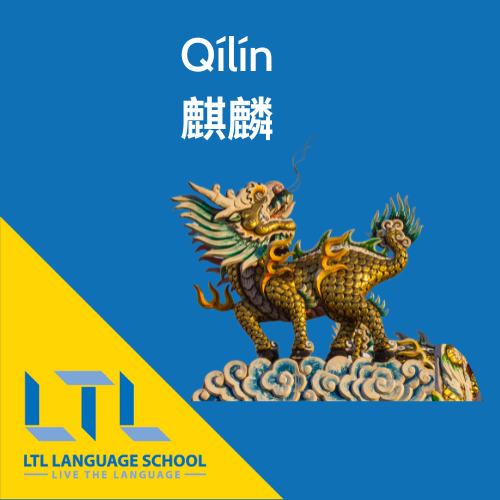
The Qílín 麒麟 is a dragon-like creature, with a flowing mane, a single horn on its forehead and a scaled body shaped like a horse.
The Qílín symbolizes good luck and prosperity, and is often interpreted to be a unicorn, despite the single horn being the only similar characteristic shared!
It is said that the rare appearance of the Qílín signifies the approaching birth or death of a significant person.
The very first Qílín is said to have appeared in the garden of the Yellow Emperor, Huangdi, and then three centuries later a pair of Qílín appeared during Emperor Yao’s rule.
DID YOU KNOW || It is said that Confucius’s birth was foretold by the arrival of a Qílín, and his death when a Qílín was injured!
BONUS || We featured 麒麟 in our post of the most complex Chinese characters. Discover some more of them with us.

The Nine-tailed Fox Spirit
The fox spirits Húlijīng 狐狸精 are shape-shifting creatures who can be either good or bad, with the Nine-tailed fox spirit, Jiǔwěihú 九尾狐, being the most well-known fox spirit.
The Jiǔwěihú are mischievous tricksters that often try to double-cross other people.
They also have the power to change shape, and often disguise themselves as young beautiful women in an attempt to lure men either for mischief or to possess their spirit.
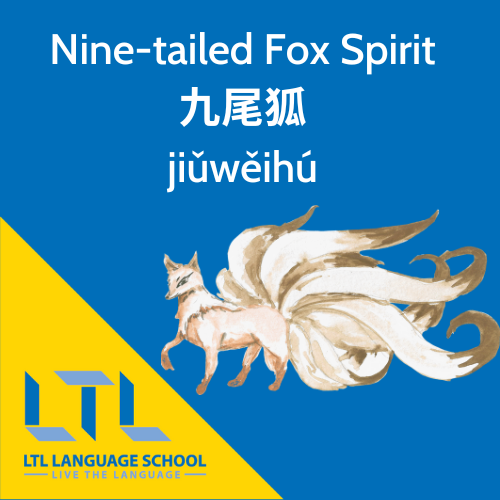
DID YOU KNOW || Due to the fox spirits infamous reputation,“狐狸精” (Húlijīng) is a slang term used as an insult aimed at a seductress or a gold-digger.
For more interesting and shocking Chinese slang, check out our post about 41 crazy chinese slang terms.
The very first mention of Jiǔwěihú is stated in the Chinese “Classic of Mountains and Seas”, dating all the way back to the Warring States period, although no exact time period and author have been determined!
Despite it’s trickster ways, the Jiǔwěihú is also considered to be an auspicious omen that appears during peaceful times, and carrying a symbol of the Jiǔwěihú is a good luck charm for attracting wealth.
The Shangyang
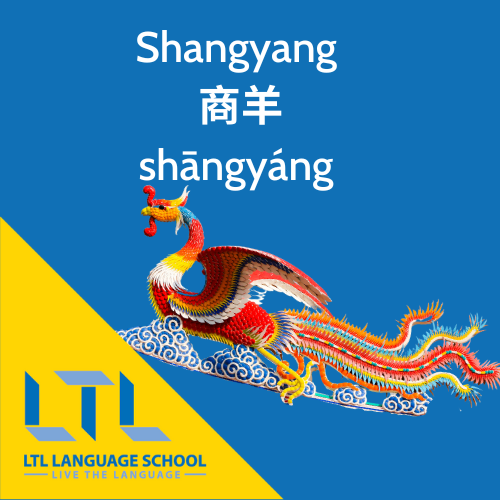
The Shāngyáng 商羊 is a mythical rainbird that predicts the beginning of rain when it dances on one leg.
Considering that rain was regarded as beneficial for agriculture in Ancient China, the Shāngyáng is an important bird in Chinese mythology.
Whenever there was a drought, people used to imitate the Shāngyáng by wearing masks, holding castanets and jumping high on one foot in hopes of attracting the rainbird to bring rain.
DID YOU KNOW || The Shanyang dance 商羊舞 (Shāng yáng wǔ) widely known in the region of Xinghuagang Village, Jiuyu Township, Juancheng County, Heze City, is an ancient sacrificial folk dance, based on the myth of the Shāngyáng rainbird.
Just like the Shāngyáng rainbird, the basic movements include jumping on one foot, or alternately lifting and jumping with both feet, but landing on both feet at the same time is not allowed!
Talking of birds, do you know how to call them in Chinese?
If not, check out our quick video to learn about the names of these birds in Chinese!
Vampires
Vampires? You read that right!
Except unlike their western blood-loving, castle-lounging counterparts, vampires in Chinese mythology are more like zombies.
A vampire, Jiāngshī 殭屍 is a reanimated dead body, whose appearance can vary from being relatively normal looking (recently deceased) to quite grotesque (decaying flesh, when reanimated after a period of decay), which is why they are unable to bend their limbs and have to move around by hopping.
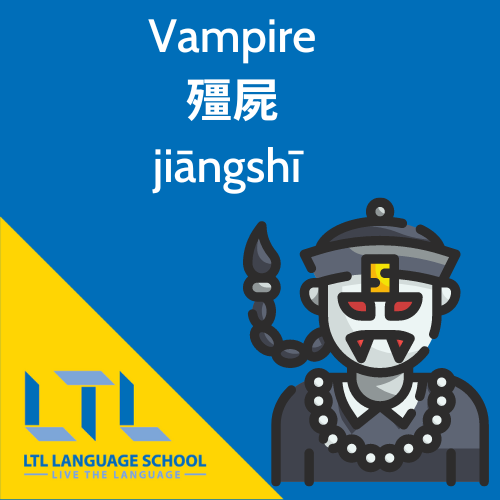
It is said that Jiāngshī have greenish skin and long white hair, with their main source of nutrition being qi, the life force, which they get from killing living creatures!
The origin story of the Jiāngshī varies, but an interesting myth about how their mythical existence came to be exists; the folk legend of “transporting a corpse over a thousand”.
Relatives of a deceased person that could not afford transportation vehicles to have the body brought back home would hire a Taoist priest to reanimate the dead person, and teach the person to “hop” back home.
As it was considered to be bad luck for the living to see the Jiāngshī, the priests would transfer the body only at night and ring bells to warn others of their presence.
DID YOU KNOW || There are speculations that the origin of myth of the Jiāngshī actually comes from smugglers that disguised their illegal activities as corpse transportation to get rid off unwanted attention!
For more spooky information, head over to our Halloween in Chinese blog post!
Xiezhi
The Xièzhì 獬豸is a very smart mythical creature vaguely resembling an ox with a horn on its head , and is said to have been able to understand human speech.
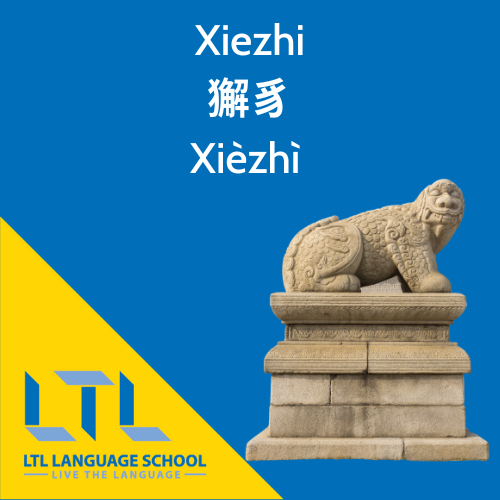
The Xièzhì is known as a symbol of justice, as it is said to have the ability to differentiate right from wrong, and when it finds corrupt officials it devours them!
The Ming and Qing Censorate (a supervisory division responsible for monitoring the civil service) wore a badge of the Xièzhì, as the Xièzhì was a symbol of justice and law.
For the normal people, the Xièzhì was considered to be a symbol of protection against evil spirits, which is why it was sometimes carved into a lock to scare off malicious spirits!
The Xièzhì was also a rather popular fashion icon throughout the various dynasties of China. During the Warring States Period, King Wen of Chu popularised the Xièzhì crown as a fashionable garment, and the judical hat used by government officials from several dynasties, including the Qin, Han and Tang, was named after the Xièzhì.
Talking of fashion, how up-to-date is your Chinese vocabulary? Head over to our clothes in Chinese post for a refresher or to learn some new interesting vocabulary!
DID YOU KNOW || A species of the giraffe from early Miocene China was named Discokeryx xiezhi after the Xièzhì, as this creature has a bony plate on the top of it’s skull, just like the Xièzhì is also said to have!
If interested in learning more about various Chinese creatures, check out the video below to get to know the 11 most scariest creatures!
Jiaoren
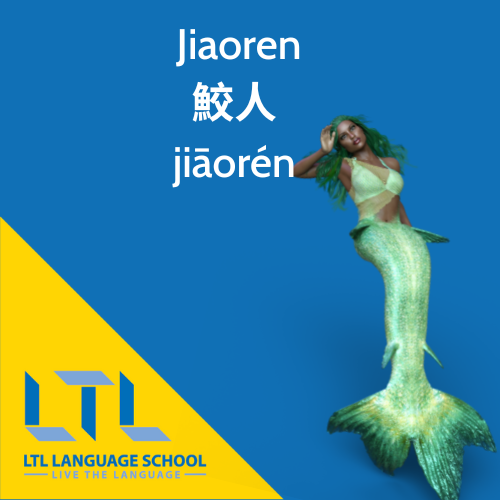
The Jiāorén 鮫人 are mysterious creatures with human-like upper bodies and tails instead of legs, that are usually found living in the South China Sea and other bodies of water, both salt and fresh water, such as lakes and rivers in China.
Physically they resemble their western counterparts, Mermaids, but the Jiāorén are known to be very skilled craftspeople, especially in weaving and it is said that their tears can turn into pearls, and that their grease can be burned for over thousands of years.
In Ren Fang’s (460-508) “Tales of the Marvellous”, the Jiāorén are known for their 蛟绡纱 (jiāo xiāo shā), or “Dragon Yarn”, a beautifully woven cloth said to be as white as frost and always dry, even under water.
Despite the Dragon Yarn being only a myth, it’s referenced throughout Imperial Chinese literature surprisingly often, by Lu You, a poet in the Song Dynasty, in the Taiping Yulan, a massive encyclopedia compiled from 977 to 983, Soushen Ji, a compilation of legends and short stories about the supernatural and several other literary works.
Speaking of Chinese literature, have you read the most well-known modern Chinese novels?
If you’re looking for more amazing books to add to your reading list, check out our useful video!
DID YOU KNOW || Based on some legends Emperor Qin Shi Huang’s tomb, guarded by the Terracotta warriors, has long-lasting lights made out of the Jiāorén’s grease.
The Monkey King
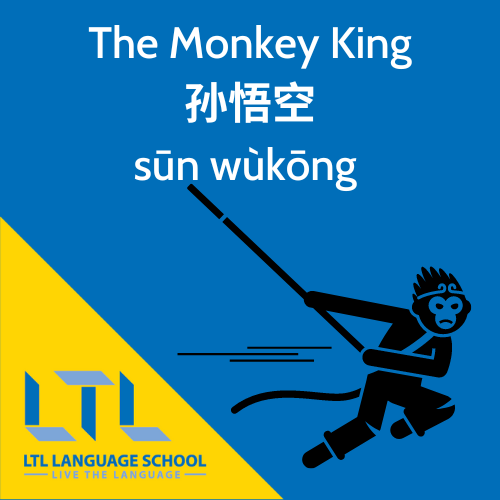
The Monkey King, also known as Sūn Wùkōng 孙悟空, is a famous figure in the classical novel Journey to the West.
Sūn Wùkōng came from a magical stone that allowed him to gain impressive abilities such as human speech, extreme strength, amazing speed and magical powers.
After emerging from the stone, Sūn Wùkōng meets other monkeys and eventually becomes their King.
However, after the death of another older monkey, Sūn Wùkōng becomes upset and decides to look for an immortal being that could teach him how to evade death.
Soon after, the exciting adventures of the Monkey King begin, from him creating chaos in the Heavens, and his subsequent 500 year imprisonment to his journey with the monk Tang Sanzang and other disciples to the West to get back the Buddhist sutras.
Monkeys have an interesting cultural and religious significance, as various religions regard them quite differently.
Chinese traditional folk religion considers monkeys to be supernatural beings, but Taoism portrays monkeys to be paradoxically both wise and foolish creatures, whereas Chinese Buddhism considers monkeys to be simply a symbol of foolishness.
DID YOU KNOW || The Monkey King has starred in quite a few media adaptations based on the novel Journey to the West, including the famous Korean drama, A Korean Odyssey!
If interested in discovering more Chinese shows, head over to our Chinese shows post that can also help you improve your Chinese!

16 Chinese Idiom Stories – Speak like a Native
16 of the Best Chinese Idioms – Our Favourites and the Stories behind them Learning Chinese idiom stories and proverbs is a brilliant way to get into higher level Chinese, and the great thing is, they aren’t that hard to…
The Jade Rabbit
The Jade Rabbit, Yùtù 玉兔, also known as the Moon Rabbit, is a mythical creature that lives on the moon with the fairy Lady Chang’e, and is responsible for making potions in the Moon Palace.
According to one of the Jade Rabbit’s legends, the Jade Emperor wanted to find someone to help him prepare the elixir of life, so he disguised himself as a beggar, ventured into a forest and pretended to be hungry, to see if anyone would be sympathetic.
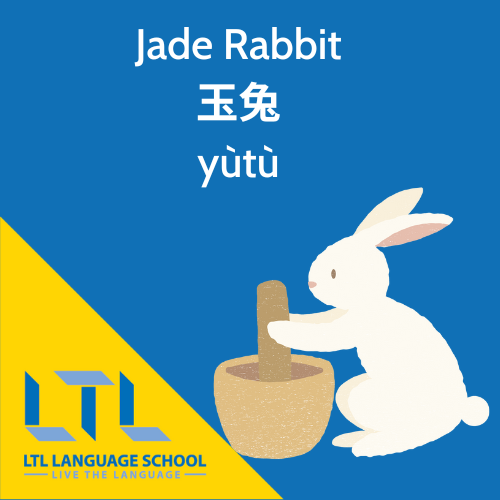
Three animals came to help, the monkey who gathered some fruit, the fox who caught fish and the rabbit who unfortunately didn’t manage to find anything.
Feeling sad that he couldn’t help the beggar, the rabbit offered to sacrifice himself so that the beggar could eat, to which the Jade Emperor revealed his true identity and stopped the rabbit from being burned.
Having found someone so selfless, the Jade Emperor carried the rabbit to the moon, where he could learn to make various potions and the most important one of all, the elixir of life!
After learning to make the elixir, the Jade Emperor was so pleased that he gifted the Jade Rabbit soft glowing white fur, which resembled jade so much, that the rabbit became known as the Jade Rabbit!
DID YOU KNOW || The Jade Rabbit is considered to be a mascot of the Chinese Mid-Autumn Festival 中秋节 (Zhōngqiū jié), which is why he is quite commonly featured on the decorations!
Check out our post about the Mid-Autumn Festival for more interesting information!
Chinese Gods and Goddesses
Chinese mythology has a vast range of various Gods and Goddesses, so let’s learn about some of them!
But first, let’s learn the Chinese meaning of these key words!
God is 上帝 (Shàngdì) || Goddess is 女神 (Nǚshén)
Bixia Yuanjun
Bixia Yuanjun 碧霞元君 (Bìxiá yuánjūn), also known as Taishan Niangniang 泰山娘娘 (Tàishān niángniáng), is the taoist Goddess of Mountain Tai in Shandong Province, childbirth, dawn and destiny.
She is a powerful Goddess with the abilities to control the human life-span and to judge the dead.
There are quite a few legends surrounding Bixia Yuanjun, some depicting her as the daughter of the Great Emperor of the Eastern Peak 泰山東嶽大帝 (Tàishān dōng yuè dàdì), a mountain God in charge of controlling life and death of the mortal humans on Earth, and who is also the Lord of the Underworld.
Other legends believe her to be the daughter of King Yan 阎王 (Yánwáng), the God of Death and Diyu 地狱 (dìyù), the realm of the dead or what is commonly referred to as hell.
DID YOU KNOW || There are nine main Mother Goddesses (Goddess of motherhood, fertility, creation, destruction) in Chinese mythology, and it is said that all of them are manifestations of Bixia Yuanjun!
The Jade Emperor
The Jade Emperor 玉皇 (Yù Huáng) or Yudi 玉帝 (Yù Dì) is one of the most important God’s in Chinese mythology.

He is the ruler of Heaven and is considered to be the very first Chinese Emperor!
The origin of the Jade Emperor varies, but a common legend is that he was a kind, wise, benevolent prince, who was respectful and helpful to all whom he met.
After becoming King and ensuring that everyone in his Kingdom was well-looked after, he decided to cultivate Tao, and after eons he achieved Golden Immortality, and after an additional hundred millions of years he finally became the Jade Emperor.
DID YOU KNOW || The Jade Emperor is a prominent character in several myths and even works of literature, such as the previously mentioned Jade Rabbit, the Zodiac animals, the Cowherd and the Weaver Girl, the Journey to the West and many others.
Pangu

Pangu 盤古 (Pángǔ) is an important figure in the creation myth, who separated heaven and earth and created our world.
According to the legend, in the beginning there was nothing, just our universe in a formless and featureless state, that eventually ended up forming a cosmic egg, from which Pangu emerged.
Pangu wasted no time, he immediately began to create the world. He created the earth and sky, and to separate them, he stood between them and pushed up the sky.
For 18,000 years, the sky grew 3 meters higher, the earth 3 meters thicker and Pangu 3 meters taller every single day.
After the 18,000 years had passed Pangu died, but his spirit still lives on. His breath became the wind, mist and clouds, his blood rivers, his muscles land, his left eye the Sun, his right eye the Moon, his fur forests and the fleas from his fur became the animals that roam earth today.
DID YOU KNOW || There is a temple dedicated to Pangu, in Huadu District, Guangdong Province, the Pangu King Temple 盤古皇廟 (Pángǔ huáng miào).
Caishen
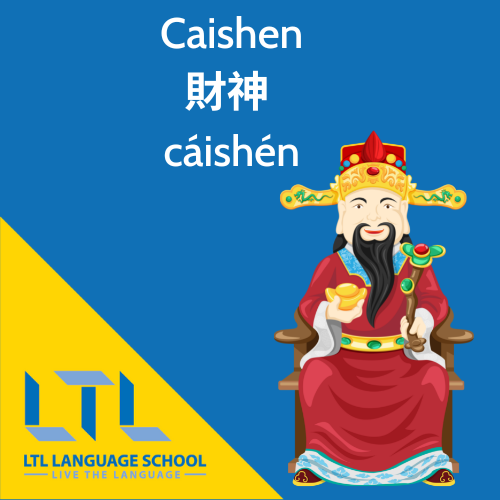
Caishen 財神 (Cáishén) is the God of wealth and money, who is prominent in Chinese folk religion and Taoism.
During the Chinese New Year when people are eager to for Caishen to bless the upcoming year with wealth and prosperity, they offer incense and invite Caishen into their home.
It’s also customary to eat dumplings, as it is though that the shape of the dumplings resembles precious metals.
After being presented with offerings, Caishen leaves for Heaven on the second day of the lunar New Year whilst being sent off by people, who pray for a good and prosperous year.
Caishen is often depicted wearing expensive luxurious silks, as rides a black tiger, and carries a golden cudgel that can turn iron into precious gold.
DID YOU KNOW || The New Year’s greeting 恭喜发财 “May you become rich” (gōngxǐ fācái) is aimed at Caishen, as he is the God of wealth.
Erlang Shen
Erlang Shen 二郎神 (Èrlángshén) who is also known as the Lord of Sichuan, is the God of Engineering who has a third all-seeing eye on his forehead. He’s also a great folk hero who helped prevent catastrophes during the ancient times.
Erlang Shen’s origin myth is debatable, as a few different variations exist.
According to a popular legend, Erlang Shen is the son of Princess Yaoji, the sister of the Jade Emperor.
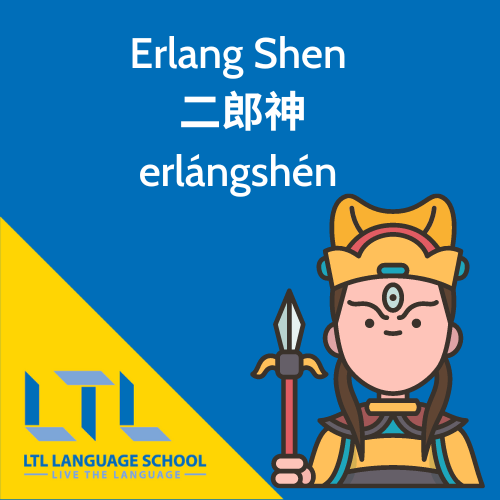
Princess Yaoji was a Goddess tasked with limiting love between mortal beings and Gods, who ironically fell in love and married a mortal man, Yang Tianyou, with whom she had 3 children; Yang Jiao, Yang Jian (Erlang Shen), and Yang Chan.
Unfortunately, once the Jade Emperor learned about her marriage, he sent armies to imprison Princess Yaoji under Mt. Tai and kill her family, with the only survivors being Erlang Shen and his sister Yang Chan.
Years later, Erlang Shen cut the Mt. Tai in half and rescued his mother.
In other variations, his mother Princess Yaoji is imprisoned in the underworld, and Erlang Shan saves his mother by throwing lightning bolts at the demons.
In another myth, Erlang Shan is the son of an engineer, Li Bing, who is hired to prevent the catastrophic flooding of the Min River.
Li Bing can’t find the source of the flooding, so he sends his son Erlang Shan to investigate the problem, who after a year of sailing up and down the river is also none the wiser.
But one day, he finds an old woman crying on the banks of the river. She tells him one of her grandchildren is going to be sacrificed to the evil dragon that had been terrorizing the region for years.
Erlang Shen comes up with a plan and tells the old woman that he will take the place of her grandchild and would be offered as a sacrifice instead.
When the dragon arrived to take his sacrifice, Erlang Shen leaped out from beneath his cloak and cut the dragon in half, bringing peace to the city and all the other neighbouring villages.
DID YOU KNOW || Just like the Jade Emperor, Erlang Shen also appears in the novel Journey to the West, when he is ordered to subdue the Monkey King after he creates havoc in Heaven.
Mazu
Mazu 媽祖 (Māzǔ) is the Goddess of the Sea, who looks after sailors and fishermen, and sends warnings about potential storms and catastrophes to those on the sea.
Mazu was originally a human named Lin Mo from Fujian, although not much about her earlier life is known.
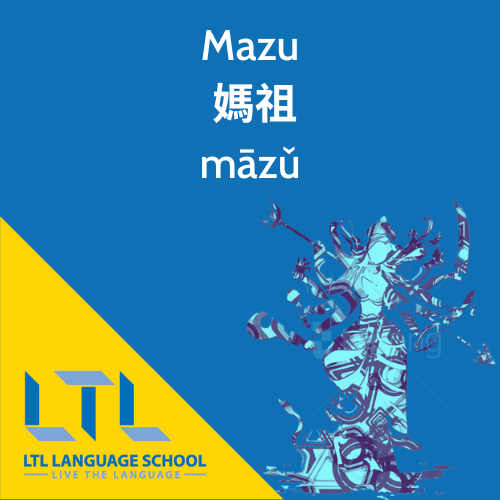
Lin Mo is said to have been born mute into a fisherman family, and despite her inability to speak, she had various supernatural powers including the ability to fall into a trance and see the future.
One day, Lin Mo’s father and brothers went fishing, a furious storm began. Lin Mo fell into a trance and projected her spirit to help her father and brothers.
However, her mother didn’t realize what Lin Mo was doing, and before Lin Mo could save her father, her mother woke her up.
Lin Mo, blinded by her grief, climbed up the tallest cliff and threw herself down into the water. Before hitting the water, Lin Mo was transformed into a beam of light, and ascended to Heaven, where she became Mazu.
Once Lin Mo became Mazu, she took a vow that she would remain on Earth until all human beings achieved enlightenment.
Mazu has quite a lot of different titles, including royal ones such as “Princess of Heaven”, “Empress of Heaven” and “Princess of Numinous Grace”.
DID YOU KNOW || When praying to Mazu in an emergency, it is advised to not use any of her royal titles, as it is said that Mazu might feel obligated to dress up and take her time to look royal, before finally answering the prayer.

What Is Panda Diplomacy & How Does It Work? 🐼
Can you really send a panda as a gift? Discover the meaning behind panda diplomacy and the history of sending pandas abroad to other countries from China.
The Dragon King
The Dragon King Longwang 龍王 (lóngwáng) is a fierce God who rules over oceans, seas and all other Dragons.
Although he’s seen as quite a hot-tempered and ferocious character, he is still considered to be a symbol of good fortune and he is quite popular among Chinese coastal regions.
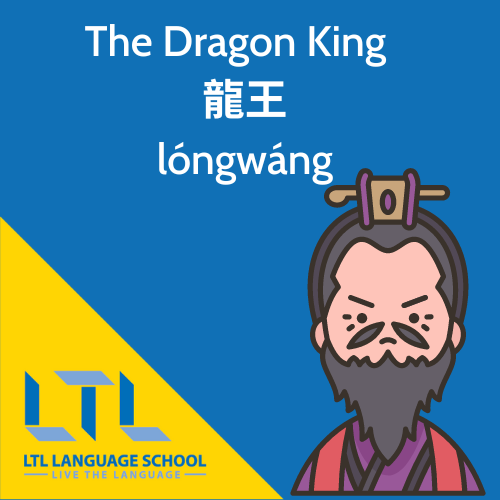
Longwang has 2 forms; his dragon form, which is typically portrayed in the style of the Chinese dragon with a snake-like body, horns and big claws, and his human form which wears luxurious royal robes.
Longwang is part of quite a large family, with four other dragon brothers; Ao Guang 敖廣 (Áo guǎng) who rules the Eastern Sea, Ao Qin 敖欽 (Áo qīn) who controls the South Sea, Ao Run 敖閏 (Áo rùn) who rules the West Sea, and Ao Shun 敖順 (Áo shùn) who governs over the North Sea.
DID YOU KNOW || Quite a lot of Chinese proverbs and idioms use the Dragon to represent a good quality or character trait.
If you would like to know more about the fascinating Gods and Goddesses in Chinese mythology, why not give the video below a quick look?
Mythology Around The World
It’s not just China that has bewitching myths and legends, so let’s take a quick look at other notable intriguing beings from other nations and times!
Ancient Rome
The Ancient Romans believed in quite a lot of Gods, and there was usually a God or a Goddess for each aspect of their lives.
Let’s learn about the 12 main Gods and Goddesses in Chinese!
| Vocabulary | Description | Hanzi | Pinyin |
|---|---|---|---|
| Jupiter | The King of Gods, and the God of thunder and lightning | 朱庇特 | Zhūbìtè |
| Juno | Goddess of women and fertility | 朱诺 | Zhūnuò |
| Mars | God of war | 玛尔斯 | Mǎěrsī |
| Mercury | God of travelers and tradesmen | 墨丘利 | Mòqiūlì |
| Neptune | God of the sea | 尼普顿 | Nípǔdùn |
| Venus | Goddess of love and beauty | 维纳斯 | Wéinàsī |
| Apollo | God of music, archery, healing, poetry and truth | 阿波罗 | Ābōluó |
| Diana | Goddess of hunting, archery, and animals | 狄安娜 | Díānnà |
| Minerva | Goddess of wisdom, learning, and the arts | 密涅瓦 | Mìnièwǎ |
| Ceres | Goddess of agriculture, harvest, and the seasons | 克瑞斯 | Kèruìsī |
| Vulcan | God of blacksmiths and volcanoes | 伏尔甘 | Fúěrgān |
| Vesta | Goddess of hearth and home | 维斯塔 | Wéisītǎ |
Ancient Greece
The Ancient Greeks also had Gods and Goddesses, who ruled the world from Mountain Olympus in Greece.
Like their Ancient Roman counterparts, they also had specific functions and roles.
Let’s see who they are!
| Vocabulary | Description | Hanzi | Pinyin |
|---|---|---|---|
| Zeus | God of the Sky | 宙斯 | Zhòusī |
| Poseidon | God of the Sea | 波赛顿 | Bōsàidùn |
| Ares | God of War | 阿瑞斯 | Āruìsī |
| Aphrodite | Goddess of Love | 阿佛洛狄忒 | Āfóluòdítè |
| Hera | Goddess of Women | 赫拉 | Hèlā |
| Demeter | Goddess of Harvest | 得墨忒耳 | Démòtèěr |
| Athena | Goddess of wisdom and military | 雅典娜 | Yǎdiǎnnà |
| Apollo | God of the Sun, Music and Poetry | 阿波罗 | Ābōluó |
| Artemis | Goddess of hunting | 阿耳忒弥斯 | Āěrtèmísī |
| Hephaestus | God of Fire | 赫菲斯托斯 | Hèfēisītuōsī |
| Hermes | The Messenger God | 赫耳墨斯 | Hèěrmòsī |
| Dionysus | God of Wine | 狄俄倪索斯 | Díénísuǒsī |
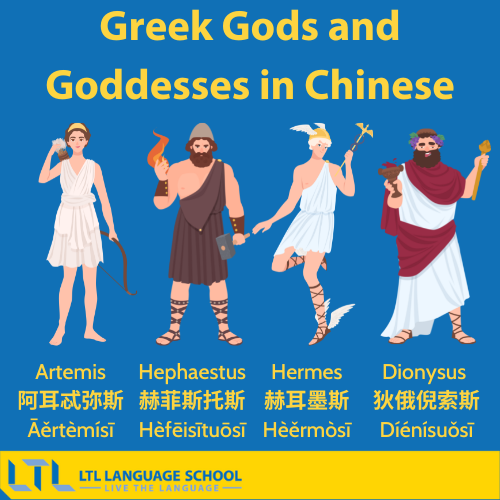
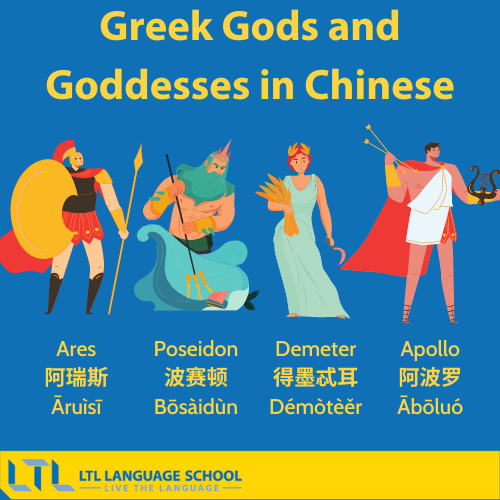
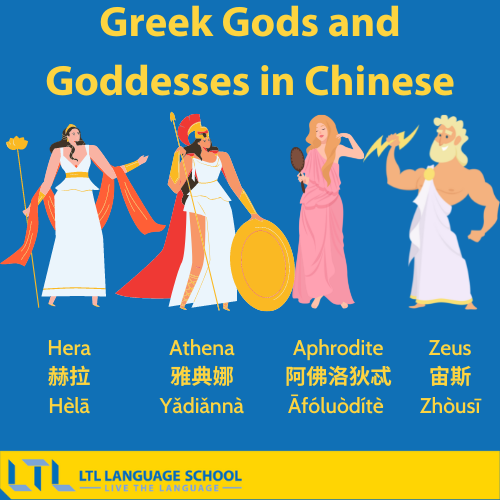
Slavic Mythology
You may have heard about the infamous witch Baba Yaga living in a chicken-legged hut and flying around terrorizing people, but how would you call her in Chinese?
Let’s take a look at some interesting figures in Slavic mythology.
| Vocabulary | Description | Hanzi | Pinyin |
|---|---|---|---|
| Baba Yaga | A malicious witch living in a chicken-legged hut and flying around in a large mortar and pestle. | 芭芭雅嘎 | Bābā yǎgā |
| Rusalka | An inconspicuous mermaid luring young men to their demise. | 鲁萨尔卡 | Lǔsàěrkǎ |
| Alkonost | A creature with the body of a bird and the head of a woman, whose beautiful song brings joy to anyone who hears it. | 阿尔科诺斯特 | Ā’ěrkēnuòsītè |
| Chort | A human-like monster with goat hooves, horns, and a tail, very similar to the Devil. | 魔鬼 | Móguǐ |
| Strzyga | A female demonic creature that is quite similar to the vampire. | 吸血妖鸟 | Xīxuèyāoniǎo |
| Koschei the Deathless | An antagonistic, skeletal sorcerer found in several folk stories, who is quite paranoid about his hidden mortal soul being discovered. | 科西切 | Kēxīqiè |
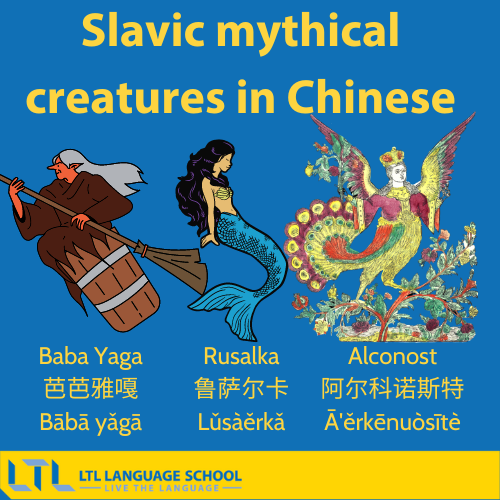
Norse Mythology
You may know about Thor and his famous hammer, but what about the other Norse mythical figures and the weird & wonderful beasts?
| Vocabulary | Description | Hanzi | Pinyin |
|---|---|---|---|
| Fenrir | Fenrir is a wolf, who is predicted to play a major part in the end of the world, Ragnarok. | 芬里尔 | Fēnlǐěr |
| Thor | Thor is the well-known god of lightning, thunder, storms, and protecting humankind. | 雷神 | Léishén |
| The Kraken | The Kraken is a giant squid or octopus creature, notorious for creating whirlpools and attacking ships. | 克拉肯 | Kèlākěn |
| The Mare | The Mare is a malicious ceature known for giving people nightmares when they sleep. | 母马 | Mǔmǎ |
| Ratatoskr | Ratatoskr is a mischievous squirrel running around Yggdrasil (Tree of life) and Nidhoggr (a dragon). | 拉塔托斯克 | Lātǎtuōsīkè |
| Huggin and Muninn | They are 2 ravens that are the helpers of Odin, flying around the world and bringing him news. | 胡金 和 穆宁 | Hújīn hé mùníng |
| Valkyries | Valkyries are female maiden warriors, who take defeated warriors to Valhalla (paradise). | 瓦尔基里 | Wǎ’ěrjīlǐ |
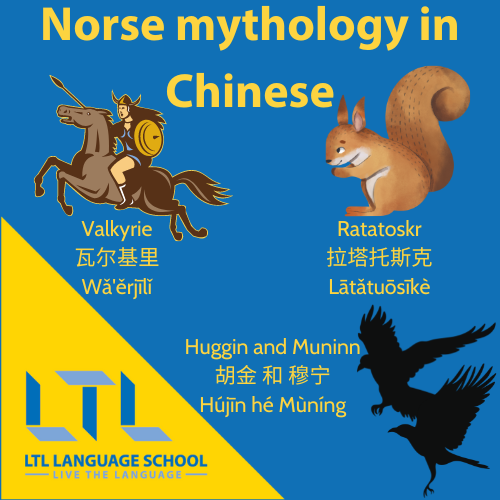
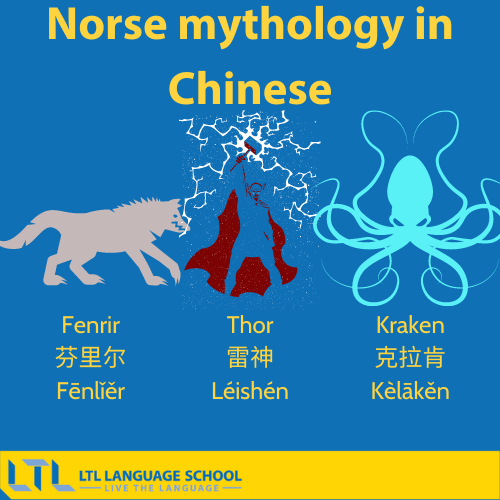
Japanese Mythology
You may know some Japanese folklore and supernatural beings from various sources, such as TV shows and movies, so let’s learn how to name them in Chinese!
| Vocabulary | Description | Hanzi | Pinyin |
|---|---|---|---|
| Kappa | A reptile-human-like creature lurking in rivers and who tries to lure people into the water. A Kappa’s favorite food is said to be cucumbers. | 河童 | Hétóng |
| Tengu | A mischievous red-faced creature who has several different forms. Tengus are said to be master swordsmen living in mountainous areas. | 天狗 | Tiāngǒu |
| Kitsune | A very intelligent fox with supernatural powers that get more powerful as the Kitsune ages. | 狐狸 | Húlí |
| Tanuki | A mischievous prankster raccoon-like creature with the ability to shape-shift into any form. | 狸猫 | Límāo |
| Yatagarasu | A 3-legged crow who is the messenger of the Gods and whose appearance is considered to be an auspicious omen. | 三足烏 | Sānzúwū |
| Shisa | Shisa is a loyal lion-dog guardian, who when placed outside temples or homes is a terrific protectors against evil spirits and bad fortune. | 风狮爷 | Fēngshīyé |
| Shikigami | Shikigami are created spirits, with their power depending on their creators spiritual strength. They are usually invisible, but can also be paper-like. | 式神 | Shìshén |
| Shinigami | Shinigami are spirits or gods that guide humans to death, similar to the Grim Reaper, except Shinigami are atcually responsible for provoking the death. | 死神 | Sǐshén |
DID YOU KNOW || Although the Shinigami Ryuk from the anime Death Note is a death God, he is quite different from the mythological Shinigami in terms of appearance and roles.
Talking of anime, did you know that Chinese anime is also quite popular and interesting to watch? Check out our post about the 10 Chinese animes that can help you learn Chinese!
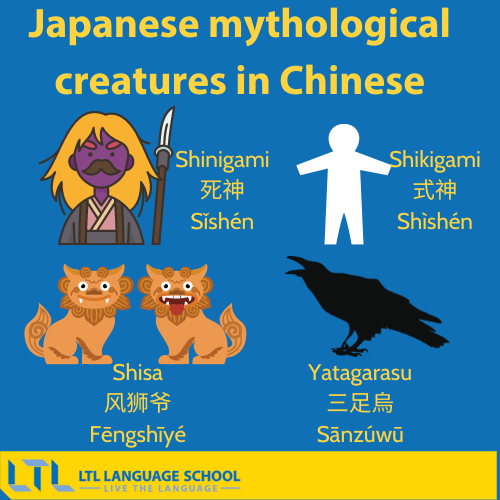

That concludes our guide to Chinese mythology. Thanks for reading this far – we hope you’ve learnt lots of new things.
If you have any questions do drop us a comment below, we’ll be happy to help.
Chinese Mythology || FAQs
How do you say “mythology” in Chinese?
In Chinese, Mythology is known as 神话 (shénhuà).
Who are the Four Guardians in Chinese mythology?
The Four Guardians are the Azure Dragon of the East, the Vermilion Bird of the South, the White Tiger of the West, and the Black Tortoise of the North.
What does the appearance of the Qílín mean?
The appearance of the Qílí means that an important person is about to be born or about to die very soon.
During which festival is the Jade Rabbit particularly significant?
The Jade Rabbit particularly significant during the Chinese Mid-Autumn Festival.
Who is considered to be one of the most important Gods in Chinese mythology?
The Jade Emperor, who is the ruler of the Heavens and who is considered to be the very first Chinese Emperor and most important Gods in Chinese mythology.
Want more from LTL?
If you wish to hear more from LTL School why not join our mailing list.
We give plenty of handy information on learning Chinese, useful apps to learn the language and everything going on at our LTL schools.
FANCY SOME FREE ONLINE LESSONS? Grab a free 7 day trial and come and see why our LTL Flexi Classes are taking language learning to a whole new level.
Sign up below and become part of our ever growing community!
![[𝗢𝗟𝗗] LTL Beihai Logo](https://old.ltl-beihai.com/wp-content/sites/17/logo-ltl-header.png)

 Hi, my name is Mojca! I am from Slovenia in Europe and I work as a student advisor at our Shanghai school.
Hi, my name is Mojca! I am from Slovenia in Europe and I work as a student advisor at our Shanghai school.

